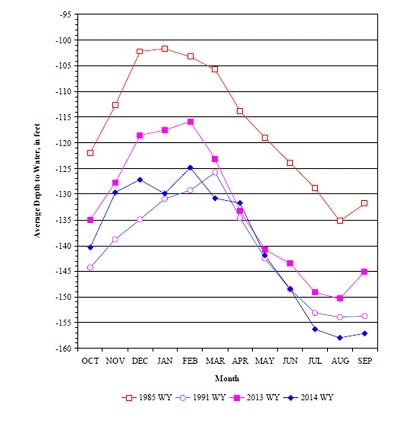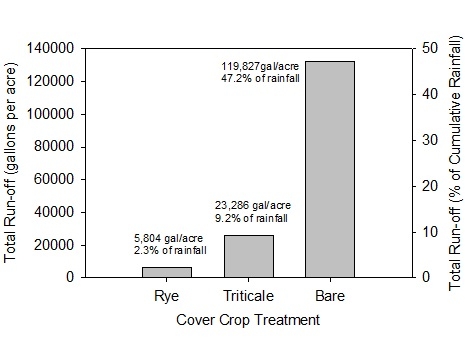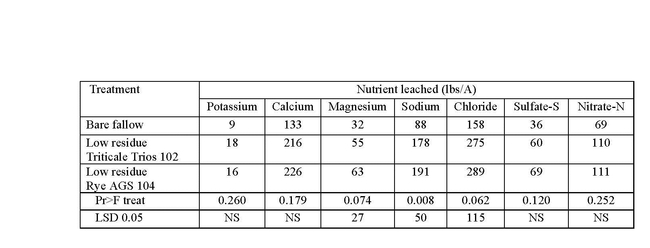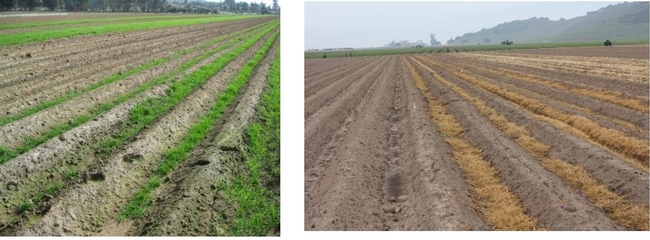Ground water levels normally fluctuate in the Salinas Valley. Water levels in the aquifer decrease during the spring and summer when crops are being irrigated and recover in the fall and winter when pumping decreases and winter rains begin (Figure 1). However, the prolonged drought has decreased groundwater depths in the Salinas Valley to historically low levels. Because of the limited supply of stored water in the Nacimiento and San Antonio reservoirs this year, groundwater recharge from the Salinas River was minimal this summer and fall. Consequently, ground water levels in areas far from the river, such as the eastside of the valley, are not recovering as rapidly as in past seasons.
As winter approaches it may be worthwhile to think about ways to maximize infiltration of rain from storm events. Ideally storms would be spread apart by several weeks to maximize infiltration, but often several storms hit the central coast within a 2 to 3 week period which contributes to flooding of roadways, erosion, and thousands of acre-feet of water flowing out to the ocean. Infiltrating as much of this rainfall as possible into your fields would maximize salt control and recharge to the aquifer beneath your fields, and minimize water quality impacts downstream.
Cover crops can improve the infiltration of water into the soil by protecting the soil surface and eliminating sealing of the soil by crusting caused by the impact of raindrops on the soil surface. In as study that we conducted from 2009 to 2011 we observed greatly improved water infiltration into the soil with the use of low residue cover crops (Figure 1). In the bare-fallow plots, 47.2% of the rainfall ran off of the field; in the rye cover crop treatment only 2.3% of the rainfall ran off. The difference of water infiltrated by the cover crop and bare treatment equaled 1/3 of an acre-foot. In addition, the infiltrated rain water has a very low salt content so it is very effective in leaching accumulated salts near the soil surface.
One concern of using cover crops on the vegetable fields in the Salinas Valley is that they will use a portion of the moisture stored in the soil during the winter. Another concern is that the cover crops can be difficult to incorporate in the soil in early spring and may delay planting. The cover crop system used in this study was not a typical full-term cover crop, but rather was a low-residue cover crop that was killed 55-60 days after planting using an herbicide. They are planted in mid to late November when evapotranspiration is low, and only allowed to produce 0.5-0.75 ton of dry biomass per acre before they are killed. Under ideal conditions the cover crop residue breaks down over the winter and does not become an issue for preparing the peaked beds for planting (see photos 1&2) and YouTube: https://www.youtube.com/watch?v=k0oVVJ_BA7s
Even dead, the residues on the soil surface are effective in increasing infiltration during rain events. The increase in water infiltration in our trials allowed for greater leaching of salts from the root zone (Table 1).
Full-term cover crops may also allow for greater infiltration of water into the soil, but because the cover crops are growing over a longer period of time over the winter, they lose water due to evapotranspiration. If the winter is particularly wet the water loss from the crop may be of no consequence, but in a drier year, the cover crop may leave the soil drier and not allow for a net gain of water to the soil. For instance in a trial conducted from 2010-11, we observed 5.5 inches of water percolated into the soil in the bare fallow treatment, but only 3.0 inches in the full-season cover crop treatment. The difference in the two treatments was due to evapotranspiration by the cover crop.
There are undoubtedly compelling reasons to use a full-season cover crop and we are not advising against their use. However, given the serious nature of the drought, we are making the argument that low residue cover crops may provide a practice to infiltrate a greater quantity of water into the soil and help contribute to groundwater recharge, especially on the eastside of the valley where recharge from the river plays a smaller role in recharging the ground water in this area. The eastside of the Salinas Valley on the sloping Chualar loam soils is a large area and if a greater proportion of this area used low residue cover crops, a greater proportion of the rainfall could infiltrate into the soil thereby contributing to groundwater recharge.



